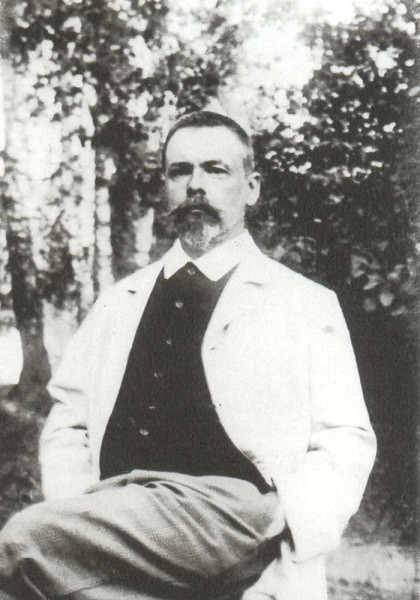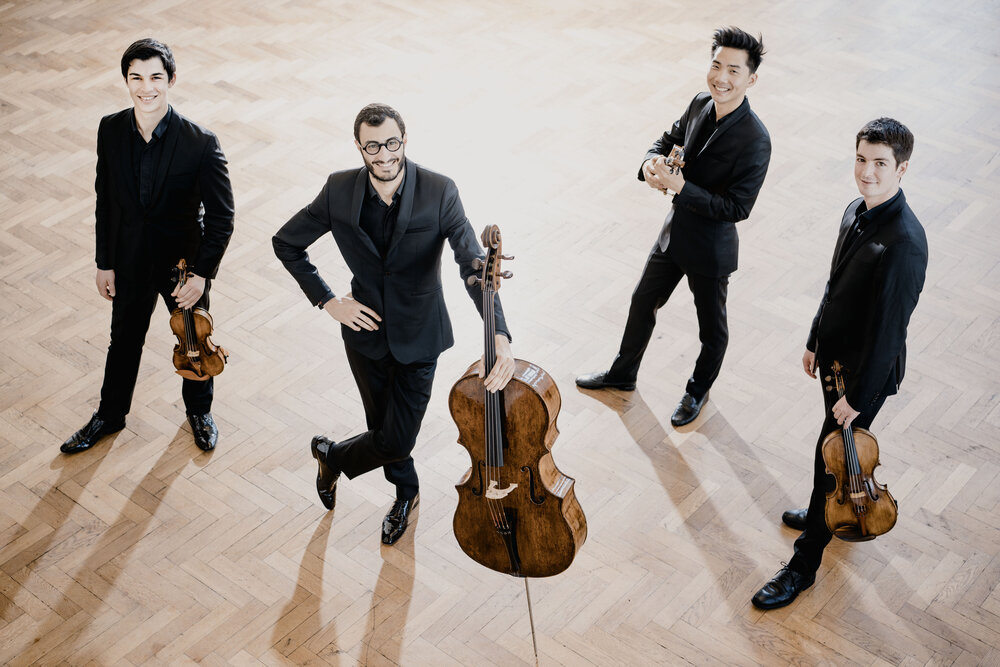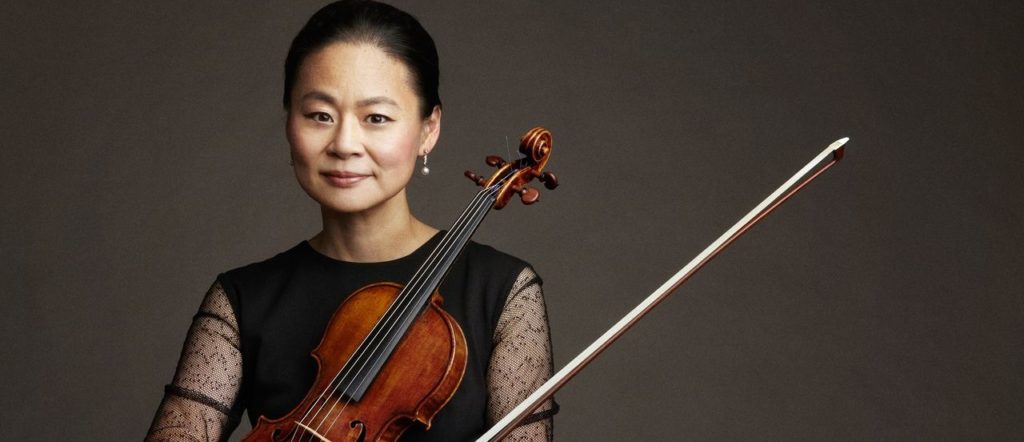Do we need another recording of the Beethoven Violin Concerto? “Need” is an interesting word. I suppose we could make do with Heifetz, Oistrakh, and Perlman—and their conductors. But the more the merrier, when it comes to recordings, and many other things in life. Plus, each performer will feel a need to make his statement. Each violinist, for example, will want to leave a mark in the Beethoven concerto: “This was my Beethoven. This is my Beethoven, in perpetuity.”
Midori has recorded the concerto for Warner Classics. Her orchestra is the Lucerne Festival Strings—supplemented by woodwinds, brass, and timpani, to be sure. Indeed, the timpani begin the piece. And who is the conductor? Well, the orchestra has a “leader,” a violinist, who sits in the concertmaster’s chair. He is Daniel Dodds, a Chinese-Australian musician. Does the Beethoven Violin Concerto need a proper conductor, standing on a podium? That is an extended discussion. Suffice it to say for now that Dodds and this chamber orchestra do just fine.
The soloist was born Midori Goto in 1971. She is the most famous one-named performer since Solomon, the British pianist born Solomon Cutner in 1902. (The most famous in classical music, that is. We are not counting Cher.) I will make some general remarks about the Midori-Lucerne Beethoven concerto.
It is crisp, smart, and tidy. One can imagine lusher, grander playing. The middle movement, Larghetto, is a little dry. But it is also honest, without pretension. The Rondo, I think, could use a little more élan. It is a touch sober for me. But, again, it is good and honest.
Besides which, you are really listening to the Beethoven Violin Concerto, as you listen to a recording such as this. After a while, you forget the performance—and are simply with Beethoven.
The album is filled out by those customary fillers-out of Beethoven Violin Concerto recordings: the composer’s two Romances, in G and F.
Midori et al. made their recording in March, just as the world was shutting down. In program notes, Midori speaks movingly about Beethoven as companion: as consoler and uplifter. Lorin Maazel, the late conductor, used to say much the same thing. Beethoven is the best friend you’ll ever have, he said. He’ll be with you through good times and bad. He’ll sympathize with you when you’re down and celebrate with you when you’re up.
Warner Classics has also released fourteen CDs of George Szell, the great conductor, in a box set. The first performance is of the Beethoven Violin Concerto, with Bronisław Huberman and the Vienna Philharmonic. They recorded it in the Konzerthaus (Vienna) in 1934. Before long, Vienna would not be safe for the likes of Szell and Huberman.
Allow me a memory of Huberman, who was born in Poland in 1882 and went on to found the Israel Philharmonic Orchestra, or the pso, as it was first known: the Palestine Symphony Orchestra. George Sgalitzer was an Austrian-American doctor, and the senior patron of the Salzburg Festival. He attended the very first performance on August 22, 1920, when he was seven years old. He died in 2006. In an interview, I asked him about his favorites: favorite conductor, favorite pianist, favorite violinist, and so on. His violinist? Huberman. He said this unhesitatingly. (His favorite conductor, by the way, was Toscanini. And his pianist: Richter.)
Indulge a memory of another interview. Some years ago, I was talking to Christopher Parkening, the American guitarist. He was saying, “I love all the great composers, of course, but, for me, there’s one who towers above all the others. And that composer is, of course”—and I broke in to say “Rodrigo.” Parkening laughed heartily.
He was going to say Bach. But my little joke was based on the fact that the most prominent guitar concerto, by far, is the Concierto de Aranjuez, which Joaquín Rodrigo wrote in 1939. It is more important to a guitarist than the Dvořák Cello Concerto is to a cellist, or than the Haydn Trumpet Concerto is to a trumpeter.
Do we “need” another recording of the Concierto de Aranjuez? Ha, arguably. The latest one comes courtesy of Thibaut Garcia, on the Erato label. He has an interesting name, this fellow: the first name French, the last one Spanish. “Thibaut” may put you in mind of Jacques Thibaud, the French violinist of old, or even of Jean-Yves Thibaudet, the French pianist. Thibaut Garcia is, in fact, French, with origins in Spain. He was born in Toulouse in 1994. He studied at the Paris Conservatory. And he plays, on his new album, with the Orchestre National du Capitole de Toulouse, conducted by a Brit, Ben Glassberg.

Their recording of the Rodrigo is splendid. Seldom has the concerto sounded less hackneyed. It is fresh, precise, joyful, and poignant. The players obviously take great pleasure in playing it, as why should they not? They play with a steady musical intelligence, too.
There is another work for guitar and orchestra on this album: the Musique de cour (court music) by Alexandre Tansman, writing in 1960. He was writing après Robert de Visée, a Frenchman of the seventeenth and eighteenth centuries. Tansman was another of those storm-tossed musicians, another Polish Jew. He became a French citizen. He wrote several pieces for Andrés Segovia, the guitar legend, including Musique de cour.
It is courtly indeed. But it is not necessarily stuffy. To the Gigue, you want to get up and dance. Young Maestro Garcia does not neglect to play some Robert de Visée—I mean, music by that Baroque composer himself, un-gussied-up by Tansman. The other composer on this album is Regino Sainz de la Maza, a Spaniard (1896–1981).
Thibaut Garcia may have “Spanish blood,” but all “foreign” guitarists are honorary Spaniards. This is true of Christopher Parkening, who comes from Los Angeles. It is true of Xuefei Yang, who comes from Beijing. We are talking about a glorious tradition, both Spanish and universal.
From Naxos, there is the first-ever recording of the Requiem by Alexander Kastalsky. The work’s formal title is a bit longer: Requiem for Fallen Brothers. It honors the dead—the Allied dead—of World War I. Kastalsky was born in Moscow in 1856. He died seventy years later, in 1926. He composed his Requiem throughout the war. It was banned in his country when the Bolsheviks rose to power, however, as all sacred music was.
Kastalsky’s Requiem was performed and recorded in the National Cathedral, Washington, D.C., in October 2018, a few weeks before Armistice Day—indeed, the centenary of the Armistice. The performers comprised four choirs (including the Cathedral Choral Society), two vocal soloists, and the Orchestra of St. Luke’s. The conductor was Leonard Slatkin, the veteran American.

The Requiem has seventeen sections, and is sometimes as operatic as it is liturgical. (You could say the same of Verdi’s Requiem.) It is a pastiche, or a collage. It incorporates the music of many countries, honoring the Allies. You hear various languages. Is there any other piece like this? While listening, I thought of Inno delle nazioni (Hymn of the Nations), by Verdi. Also of the War Requiem, which Britten wrote in the early 1960s. But those are really different from the Kastalsky.
I have said that this Requiem incorporates many musical traditions and the relevant languages, which is true. Still, the work as a whole is unmistakably Russian. At times, I thought of two works by Rachmaninoff: the Vespers and The Bells. They were composed in essentially the same years as this Requiem.
In the Requiem, there is good and inspired music. Also bombastic or insipid music. The work is a mixed bag in more ways than one. Section No. 8 is Beati mortui, employing a Romanian melody. It is beautiful. Section No. 13 could be a bass aria in a Russian opera. The next section is a dystopian rendering of “Rock of Ages” (seriously). Two sections on, you have Interludium: Hymn to Indra. It is a little hokey. Bizet did Indian-ish music better in his opera The Pearl Fishers, and so did Rimsky-Korsakov, in his opera Sadko (which features the “Song of India,” or the “Song of the Indian Guest”). But Kastalsky’s hymn is undoubtedly well-meaning.
As is the whole Requiem. I don’t want to knock it, or even judge it, because the effort is so sincere, and the horror of the war so great. I have a question: Did Kastalsky consider including the enemy dead? Or would that have been too much to ask? At any rate, it’s good that this work is on vinyl—or the modern equivalent—and Leonard Slatkin makes a yeoman case for it. He presides over his sprawling forces, in this sprawling work, with intelligence and heart.
Erato has an album called Death and the Maiden. Naturally, the major work is Schubert’s String Quartet No. 14 in D minor, known as “the ‘Death and the Maiden.’ ” This is because Schubert’s song of that title shows up in the second movement. The album also has Schubert’s famous Quartettsatz (Quartet Movement) in C minor, which was the opening movement of a string quartet never completed. There is a third Schubert work here: the String Quartet No. 4 in C major, D. 46. Whoa. Where has that been all my life?
The players are the Arod Quartet, based in Paris. The four members are still in their twenties. “Arod”? I will quote from PR materials: “The group takes its name from Legolas’s horse in J. R. R. Tolkien’s epic Lord of the Rings trilogy; in Tolkien’s mythic Rohirric language, Arod means ‘swift.’ ”

Schubert wrote his String Quartet No. 4 in 1813, when he was seventeen years old (more than halfway through his life, I’m afraid). It is seldom programmed, and the Arod decided to record it for this reason. The players also wanted to trace the composer’s musical development.
The first movement, they play with poise, musicality, and bite. This is not drawing-room playing. The music has ardor and drama. Also, the players are unified, giving a lesson in coherence. Schubert’s second movement is a song—a simple, profound song. He had an endless number of them. Has any composer ever had a greater melodic gift? The Arod players do the song the favor of leaving it free of sentimentalism.
To the third movement, a minuet, they apply great vigor and incisiveness. The final movement is pulsing with sheer Schubertian joy (a less common quality than Schubertian melancholy, but equally impressive).
The String Quartet No. 4 is a discovery for me, as is the Arod. These guys play the work as though it were a masterpiece, which it may be.
Hélène Grimaud’s new album is The Messenger (Deutsche Grammophon). The title will make sense in a moment. Grimaud is a veteran French pianist—how odd it is to write that phrase, because La Belle Hélène seems forever young!—and her album includes both solo music and music with orchestra. Her orchestra is the Camerata Salzburg. There are two composers on the album: Mozart and Silvestrov.
Valentyn Silvestrov is a Ukrainian, born in 1937. His wife, Larissa Bondarenko, a musicologist, died in 1996. Silvestrov then wrote a ten-minute work for piano and strings, The Messenger. Hélène Grimaud plays it twice. What I mean is, she plays the version for piano and strings, with the Camerata Salzburg, and also a solo-piano version. Silvestrov quotes Mozart extensively in The Messenger. Here is a statement that Silvestrov has made about his music at large: “It is a response to and an echo of what already exists.”
The list of pieces that Silvestrov wrote after his wife died makes for rather painful reading. It began with The Messenger. Then: Requiem for Larissa. Epitaph. Epitaph L. B. Autumn Serenade. Requiem. Then a hymn and a symphony. Then: Lacrimosa.
In The Messenger, Silvestrov quotes Mozart as if in a dream. The music is far away, in thought. The piece in general is spare, unadorned, “white.” It proceeds in a stately, dream-like way. I thought of Spiegel im Spiegel, the famous piece (1978) by Arvo Pärt. The solo-piano version of The Messenger is even more personal than the piano-and-orchestra one, I think—perhaps because there is just one person playing (and remembering?). The more I listened to The Messenger, in either version, the more I liked it. One must be patient with it and accept it on its own terms. It is a slow-builder, and Silvestrov is his own man, composing not so much for you and me as for himself, and Larissa.
There is another piece by Silvestrov on this album—another piece for piano and orchestra. It, too, responds to and echoes other composers: Schubert and Wagner. The work is called Two Dialogues with Postscript. The three components are “Wedding Waltz,” “Postludium,” and “Morning Serenade.” Is the second piece—not the third—the “postscript”? I imagine so, but don’t really know. This work is much like The Messenger. The music seems so personal—and so sad—you almost wish it were private, not released out onto the world.
The latest from Diana Damrau is Tudor Queens (Erato). The title refers to Donizetti’s Three Queens, as they are commonly known: Anne Boleyn (the title character in Anna Bolena); Mary, Queen of Scots (Maria Stuarda); and Elizabeth I (who appears in Roberto Devereux). Damrau is a German soprano and one of the leading singers of our time. She has triumphed in Donizetti before, notably in Lucia di Lammermoor. As she approaches fifty, it is natural for her to want to turn to the Three Queens—the territory of Callas, Sutherland, Sills, Caballé, and others.
Does Damrau, a beautiful lyric, have enough voice for these roles? That is a subject for debate. In any case, she has made a studio recording, and she has recorded excerpts, not complete operas. Along with her is the Santa Cecilia orchestra of Rome, conducted by Sir Antonio Pappano.
The fabulous Damrau instrument has taken on some wear and tear. Vibrato is wider. Top notes are thinner. On the interpretative front, I’m not sure I believe her when she scalds, imperiously. It is not merely a matter of vocal quality, including heft. Damrau is such a warm, lovable, good human being, I’m not sure I buy her as an imperious scalder. She is better, I believe, in tenderer, more songful stretches of Donizetti.
You or I may have doubts about Damrau’s suitability to these roles, but there is no doubt that she brings many outstanding qualities to them. Among these qualities are technical agility, musical instincts, and sympathy. Midori wanted to memorialize her Beethoven concerto. Thibaut Garcia wanted to display his Concierto de Aranjuez. I can certainly understand Diana Damrau’s desire to have a go at the Three Queens.
A new soprano, Fatma Said, has made an album called El Nour (Warner Classics). As suggested by that “El”—as opposed to “Al”—Said is Egyptian. “Nour” means “light.” A native of Cairo, Said went to Berlin, to study at the Hanns Eisler School of Music. Then she went to Milan, to study at La Scala’s academy. On her new album, she sings French songs and Spanish songs—and Arab songs.
One of the composers is Dawood Hosni, an Egyptian who lived from 1870 to 1937. He was born David Haim Levi. His story is interesting, as most people’s stories tend to be.
The Arabic language is beautiful out of Fatma Said’s mouth. And she sings these songs with the occasional hint of a wail, which is lovely.
A soprano from an earlier generation, Victoria de los Angeles, introduced many of us to Spanish songs—not just art songs but folk songs, too. Leontyne Price used to call herself an “American troubadour.” Wherever she was in the world, she put spirituals at the end of her recital program. As she explained it, her attitude was, “I have sung your songs. Now you will listen to mine.” From Fatma Said, I have learned some songs I never knew. This sharing of songs is one of the nicest parts of the whole enterprise.


